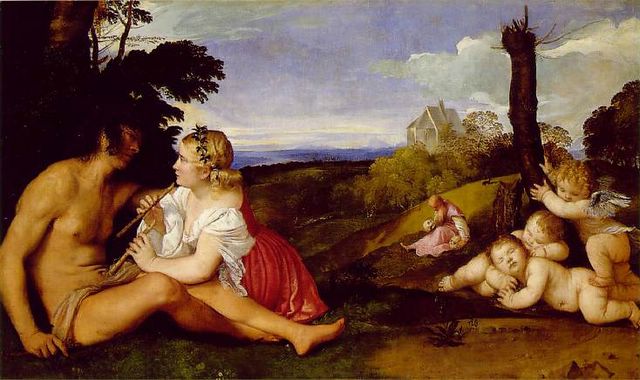Agamben & Post-Proletarians
DesoeuvrementChapter 19 from Giorgio Agamben’s The Open: Man & Animal
Translated from the Italian by Kevin Attell.
In the Kunsthistorisches Museum of Vienna there is a late work by Titian (defined by some, indeed, as his ultima poesia, something of a farewell to painting) known as the Nymph and Shepherd.

The two figures are represented in the foreground, immersed in a dark country landscape; the shepherd, seated facing us, holds a flute in his hands as if he had just taken it from his lips. The nymph, nude and represented from the back, lies stretched next to him on a leopard’s skin, a traditional symbol for wantonness and libido, showing her full and luminous hips. With a studied gesture, she turns her pensive face toward the viewers, and with her left hand lightly touches her other arm in a sort of caress. A little further in the distance, there is a tree that has been struck by lightening, half dry and half green, like the tree in the allegory of Lot, against which an animal – a “bold goat” according to some, but perhaps a fawn – dramatically rears up, as if to nibble at its leaves. Still higher, as is often the case in the late, impressionist Titian, one’s gaze becomes lost in a vivid mass of painting.
Faced with this enigmatic paysage moralise immersed in an atmosphere of both exhausted sensuality and subdued melancholy, scholars have been left perplexed, and no explanation has seemed complete. To be sure, the scene is “too much fraught with emotion to be an allegory,” and yet “this emotion is too restrained and somber for any of the suggestions proposed” (Panofsky, Erwin. Problems in Titian, Mostly Iconographic). It seems obvious that the nymph and the shepherd are linked erotically; but their relationship, at once promiscuous and remote, is so peculiar that they must be “despondent lovers, so near to each other in body yet so far apart in sentinment” (Panofsky). And everything in the painting -- the nearly monochromatic tone of the colors, the dark and brooding expression of the woman, as well as her pose – “suggests that this couple have eaten from the Tree of Knowledge and that they are losing their Eden” (Dundas, Judith. “A Titian Enigma” in Artibus et Historiae 12, 1985).
The relation of this painting to another by Titian, The Three Ages of Man, in the National Gallery of Scotland in Edinburgh, has been rightly observed by Judith Dundas. According to the scholar, the painting in Vienna – done many years later – takes up several of the elements of the earlier work (the pair of lovers, the flute, the dry tree, and the presence of an animal, probably the same one), but presents them in a darker, more despairing key which no longer has anything in common with the crystalline serenity of the Three Ages.

But the relation between the two canvases is, however, much more complex than this, and one is led to think that Titian has intentionally returned to the work from his younger years, and in a further investigation of their common erotic theme has recanted the earlier work point for point (in the Edinburgh painting – as attested to by the presence of the Erota and dry tree – the iconographic theme of the “three ages of man” is also treated in the form of a meditation on love). First of all, the figures of the two lovers are inverted; for in the earlier work, the man is nude and the woman clothed. She, who is represented not from behind but in profile, here holds the flute which will pass into the hands of the shepherd in the Vienna painting. In the Three Ages we also find, on the right, the shattered and dry tree – symbol of knowledge and of sin – on which an Eros is leaning; but when taking the motif up again in the late work, Titian has it blooming on one side, thus bringing together in a single trunk the two Edenic trees, the Tree of Life and the Tree of Knowledge of Good and Evil. And while in the Three Ages the fawn is tranquilly stretched on the grass, it now takes place of Eros and rises up the Tree of Life.
The enigma of the sexual relationship between the man and the woman, which was already at the center of the first painting, thus receives a new and more mature formulation. Sensual pleasure and love – as the half-bloomed tree bears witness – do not prefigure only death and sin. To be sure, in their fulfillment the lovers learn something of each other that they should not have known – they have lost their mystery – and yet have not become any less impenetrable. But in this mutual disenchantment from their secret, they enter, just as in Benjamin’s aphorism, a new and more blessed life, one that is neither animal nor human.
It is not nature that is reached in their fulfillment, but rather (as symbolized by the animal that rears up the Tree of Life and of Knowledge) a higher stage beyond both nature and knowledge, beyond both concealment and disconcealment. These lovers have initiated each other into their own lack of mystery as their most intimate secret; they mutually forgive each other and expose their vanitas. Bare or clothed, they are no longer either concealed or unconcealed – but rather, inapparent {inapparenti}. As is clear from both the posture of the two lovers and the flute taken from the lips, their condition is otium {leisure}, it is workless {senz’opera}. If it is true, as Dundas writes, that in these paintings Titian has created “a realm in which to reflect on the relationship between body and spirit,” in the Vienna painting this relationship is, so to speak, neutralized. In their fulfillment, the lovers who have lost their mystery contemplate a human nature rendered perfectly inoperative – the inactivity inoperosita} and desoeuvrement of the human and animal as the supreme and unsavable figure of life.
{ Agamben here moves beyond Nietzsche’s strenuous “beyond Good & Evil” and also beyond Derrida’s convoluted point about human shame at being observed nude by an animal. He gives new meaning to the old term “idyll”, which this entire iconography gestures toward much more than to vanitas. Here the lovers passively lollygagging in their fulfillment beyond shame and beyond ambition and beyond mystery are the very icon of a postmodern potential. The title of this chapter, is a French coinage that bears the connotation of de-proletarian-ization, a peaceful rest from the relentless industry of our era, beyond exchange value. If the deep history of western humanism and political theory has been founded upon a humanity-as-producer, then here in an idyll from that history, an interlude of idle resignation, of illuminated disillusionment. Yet it is this same passive closure that paradoxically opens toward a blessed status. }



0 Comments:
Post a Comment
<< Home